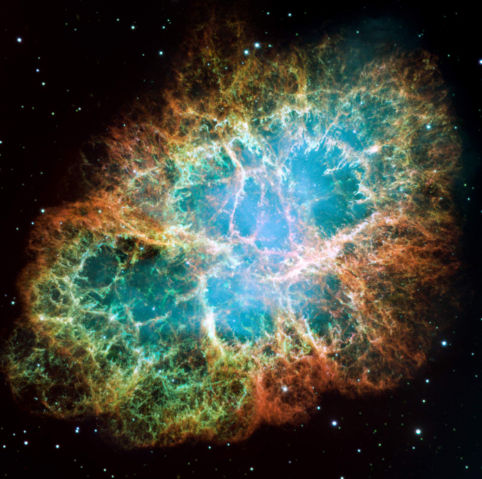From Wikipedia, the free encyclopedia
 Size of this preview: 482 × 479 pixels
Size of this preview: 482 × 479 pixels Full resolution (2,224 × 2,212 pixels, file size: 3.08 MB, MIME type: image/jpeg)
 |
This is a file from the Wikimedia Commons. The description on its description page there is shown below.Commons is a freely licensed media file repository. You can help.
|
 |
This image was selected as picture of the day on the English Wikipedia for December 25, 2006. |
 |
This is a featured picture on English Wikipedia and is considered one of the finest images.
- If you think this file should be featured on Wikimedia Commons as well, feel free to nominate it.
- If you have an image of similar quality that can be published under a suitable copyright license, be sure to upload it, tag it, and nominate it.
|
 |
Summary
| Description |
English: This is a mosaic image, one of the largest ever taken by NASA's Hubble Space Telescope of the Crab Nebula, a six-light-year-wide expanding remnant of a star's supernova explosion. Japanese and Chinese astronomers recorded this violent event nearly 1,000 years ago in 1054, as did, almost certainly, Native Americans. The orange filaments are the tattered remains of the star and consist mostly of hydrogen. The rapidly spinning neutron star embedded in the centre of the nebula is the dynamo powering the nebula's eerie interior bluish glow. The blue light comes from electrons whirling at nearly the speed of light around magnetic field lines from the neutron star. The neutron star, like a lighthouse, ejects twin beams of radiation that appear to pulse 30 times a second due to the neutron star's rotation. A neutron star is the crushed ultra-dense core of the exploded star. The Crab Nebula derived its name from its appearance in a drawing made by Irish astronomer Lord Rosse in 1844, using a 36-inch telescope. When viewed by Hubble, as well as by large ground-based telescopes such as the European Southern Observatory's Very Large Telescope, the Crab Nebula takes on a more detailed appearance that yields clues into the spectacular demise of a star, 6,500 light-years away. The newly composed image was assembled from 24 individual Wide Field and Planetary Camera 2 exposures taken in October 1999, January 2000, and December 2000. The colors in the image indicate the different elements that were expelled during the explosion. Blue in the filaments in the outer part of the nebula represents neutral oxygen, green is singly-ionized sulfur, and red indicates doubly-ionized oxygen.
Français : Cette image, une des plus grande de la Nébuleuse du Crabe jamais prise par le télescope spatial Hubble de la NASA, est en réalité une mosaïque de plusieurs clichés. La nébuleuse s'étend sur une distance de six années-lumière et est composée des restes de l'explosion d'une supernova. Les astronomes chinois et japonais ont observé cette violente explosion il y a environ un millénaire, en 1054, comme l'ont certainement également fait les indiens d'Amérique. L'image est formée de l'assemblage de 24 prises individuelles de la Caméra 2 Planétaire et Grand Champ datant d'octobre 1999, janvier 2000 et décembre 2000.
|
| Source |
This media is lacking source information.
Please edit this file's description and provide a source.
العربية | Česky | Deutsch | English | Español | Français | Italiano | 日本語 | 한국어 | Nederlands | Polski | Português | Русский | 中文 | 中文(简体) | 中文(繁體) | +/-
|
| Date |
December 2000 |
| Author |
NASA |
Permission
( Reusing this image) |
Material credited to STScI on this site was created, authored, and/or prepared for NASA under Contract NAS5-26555. Unless otherwise specifically stated, no claim to copyright is being asserted by STScI and it may be freely used as in the public domain in accordance with NASA's contract. However, it is requested that in any subsequent use of this work NASA and STScI be given appropriate acknowledgement. STScI further requests voluntary reporting of all use, derivative creation, and other alteration of this work. Such reporting should be sent to copyright@stsci.edu.
|
Licensing
 |
This file is in the public domain because it was created by the European Space Agency and NASA. Hubble material is copyright-free and may be freely used as in the public domain without fee, on the condition that ESA and NASA is credited as the source of the material. The material was created for ESA by the Hubble European Space Agency Information Centre and for NASA by STScI under Contract NAS5-26555. or . |
|
File history
Click on a date/time to view the file as it appeared at that time.
|
|
Date/Time |
Dimensions |
User |
Comment |
| current |
21:26, 9 March 2006 |
2,224×2,212 (3.08 MB) |
Stianbh |
|
|
|
00:35, 16 January 2006 |
400×400 (23 KB) |
DragonFire1024 |
|
File links
The following pages on Schools Wikipedia link to this image (list may be incomplete):
This file contains additional information, probably added from the digital camera or scanner used to create or digitize it. If the file has been modified from its original state, some details may not fully reflect the modified file.


